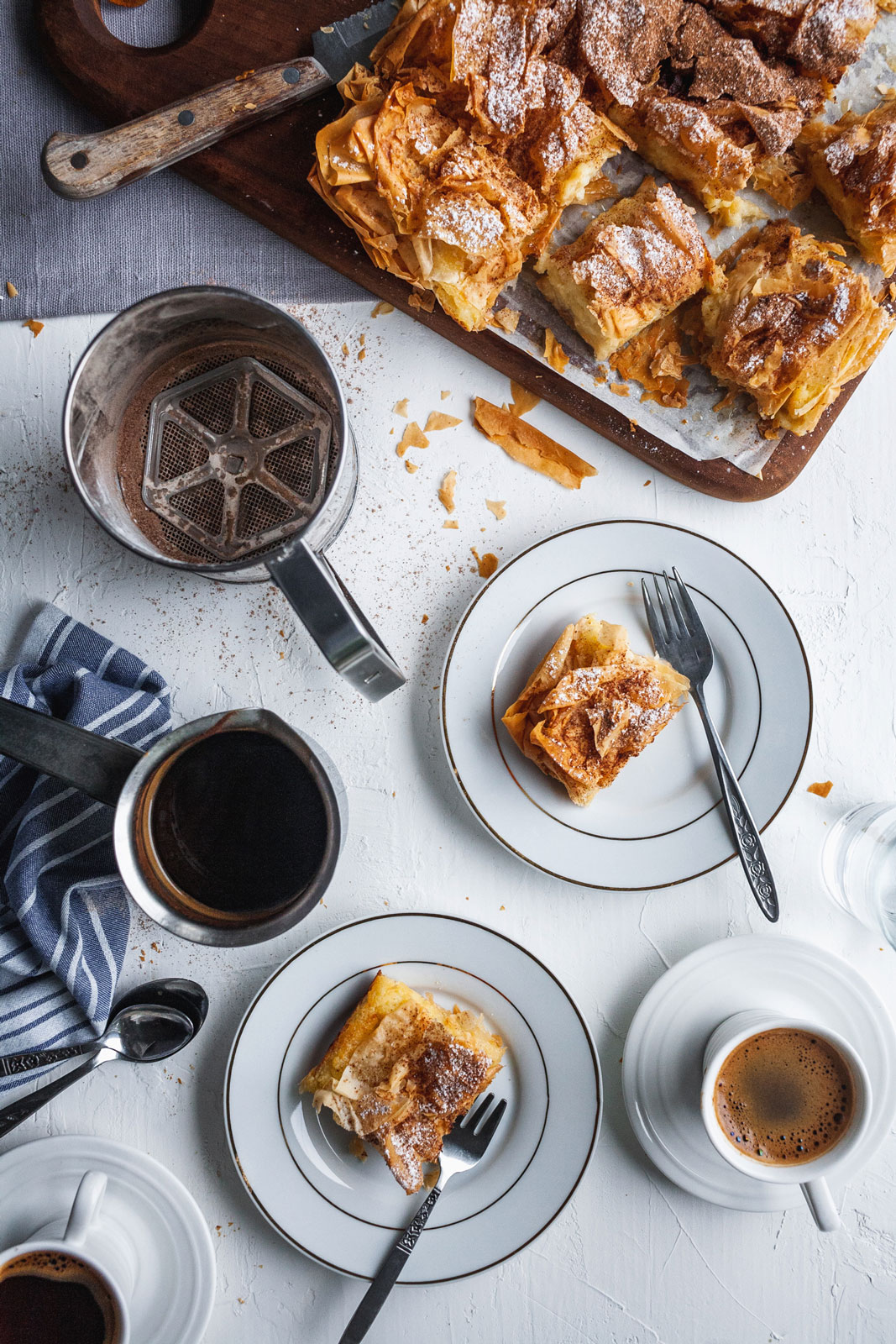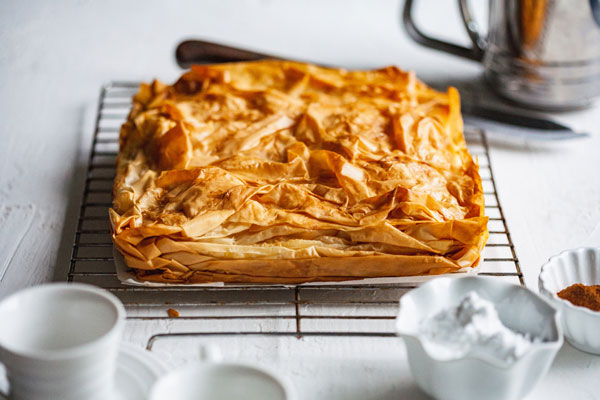Bougatsa – Greek-Style Custard Pastry
This Bougatsa - Greek style Custard Pie or Pastry tops the list when it comes to hubby’s favourite Greek foods. I don’t blame him as nothing is more welcoming than the aroma of it baking in the oven. It’s most delicious warm out of the oven too. Crispy layers of buttery phyllo make up the top and bottom layers of this delicious Greek delight and enveloped in those layers lies a creamy custard made of milk and semolina and slightly sweetened with a dash of sugar and flavoured with vanilla and optionally a little lemon juice and zest. Sounds like I’m making a big deal out of phyllo and cream and I definitely am because it’s just that good. I view it as the Greek equivalent to a custard filled croissant - buttery, crispy, delicious, cream filled and perfect with your morning beverage.
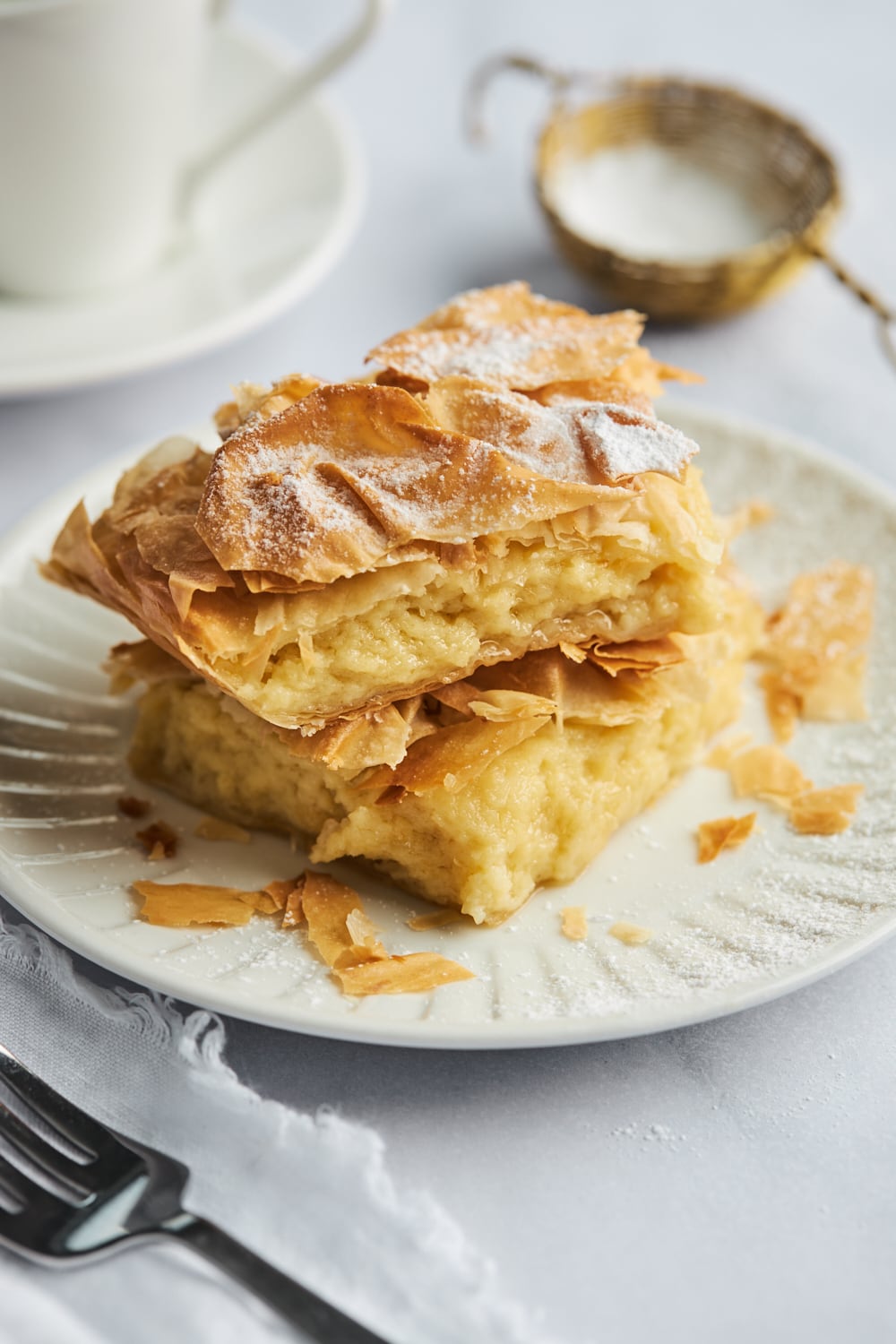
What Is Bougatsa?
Bougatsa - is a famous Greek Pastry eaten all over Greece and most commonly for breakfast. A creamy custard filled phyllo pastry sliced and dusted with powdered sugar or cinnamon or both. Bougatsa has origins from the Byzantine period, when Constantinople was Greek and it has evolved some since that period. There are several varieties of bougatsa depending on the region in Greece. This bougatsa is very popular especially in northern Greece Thessaloniki with a creamy custard filled phyllo pastry or pie. Some make it with flour and others with semolina - a Greek Semolina custard wrapped in buttery phyllo pastry. This particular one is made with fine semolina (Simigdali) which adds a wonderful texture to the creamy custard. In Crete - Chania more specifically they make Bougatsa or at least the custard with cheese - Mizithra cheese for a more savory flavour. I have yet to meet a version I don’t like - you really can’t go wrong with a creamy or a cheesy custard filled phyllo pastry!!
Bougatsa vs Galaktoboureko
Both bougatsa and galatoboureko are popular Greek delights made with lightly sweetened custard in between layers of phyllo. Galaktoboureko is a traditionally served as a dessert and is in the syropiasta (syrup based) family of Greek Desserts. After it is baked it is drenched in a sweet syrup that sort of soaks through but leaves the top layer still crisp while the rest is creamy custard with a syrupy phyllo base. Bougatsa, on the other hand, is traditionally eaten for breakfast although as I mentioned above there are no rules - it can be eaten whenever. There is no syrup used in bougatsa. When it is baked and sliced it is dusted with confectioners sugar and cinnamon or one or the other. I like a dusting of both but others are more particular about what they top there’s with. Bougatsa is often eaten or served for breakfast but can easily work it’s way into being a snack and of course a mildly sweet dessert. Serves up perfectly on a brunch or brekkie table dusted with cinnamon and powdered sugar and served with some Greek coffee. My husband prefers it any time and all the time. Him and my father favour custardy things so this and it’s honey soaked counterpart galaktoboureko, are their favourites and are what they request the most.
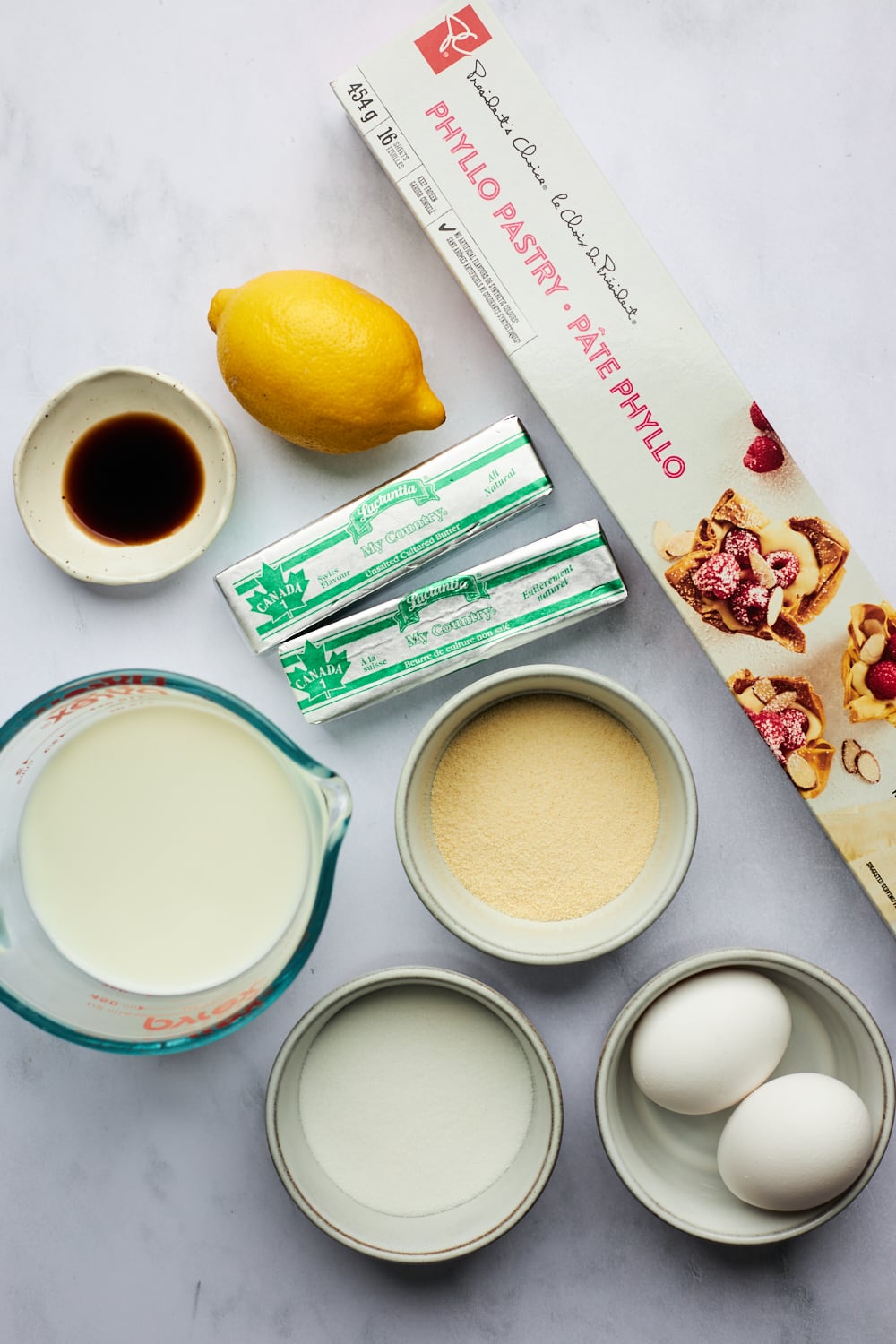
Bougatsa Ingredients
- Phyllo dough/filo Pastry: I always use storebought which you can buy from the frozen section of the grocery store - thaw overnight in the fridge (better than on the countertop as the phyllo sheets could get a bit soggy from the condensation)
- Butter: I use unsalted butter for this recipe - you will need it for the custard and for lightly brushing between layers of phyllo pastry (I like the custard quite creamy and the ½ cup of softened butter added does just that - if you would like to reduce the amount of butter in the custard you can by up to ½ the amount so ¼ cup of butter will still work)
- Eggs: You will need 1 whole egg and 1 yolk ( I have tried all sorts of variations and the 1 egg and 1 yolk produces the best texture - creamy and not overly firm)
- Milk: Whole milk works best for best flavour and richness for the custard
- Sugar: granulated sugar is what you will need for the custard and powdered sugar for dusting bougatsa before serving if desired. Only ¼ cup granulated sugar and its lightly sweet - if you prefer it sweeter feel free to increase the amount to half a cup.
- Semolina: Fine semolina is what I use. Semolina is a type of flour made from durum wheat. I almost always use semolina for the custard in my bougatsa and my galaktoboureko but the recipe can also made with all purpose flour as well - replace semolina with equal amounts all purpose flour more tips below in the variations section
- Lemon Zest: Lemon Zest is optional but adds a really nice flavor to the custard - its not overwhelmingly lemony in any way - just a hint (say optional bt on testing the recipe many times - I prefer adding it - it gives the custard such a nice flavour - without it I find it quite bland)
- Vanilla Extract: I strongly recommend using Pure vanilla extract for best flavour for the custard
- Powdered Sugar & Cinnamon: for dusting the bougatsa before serving
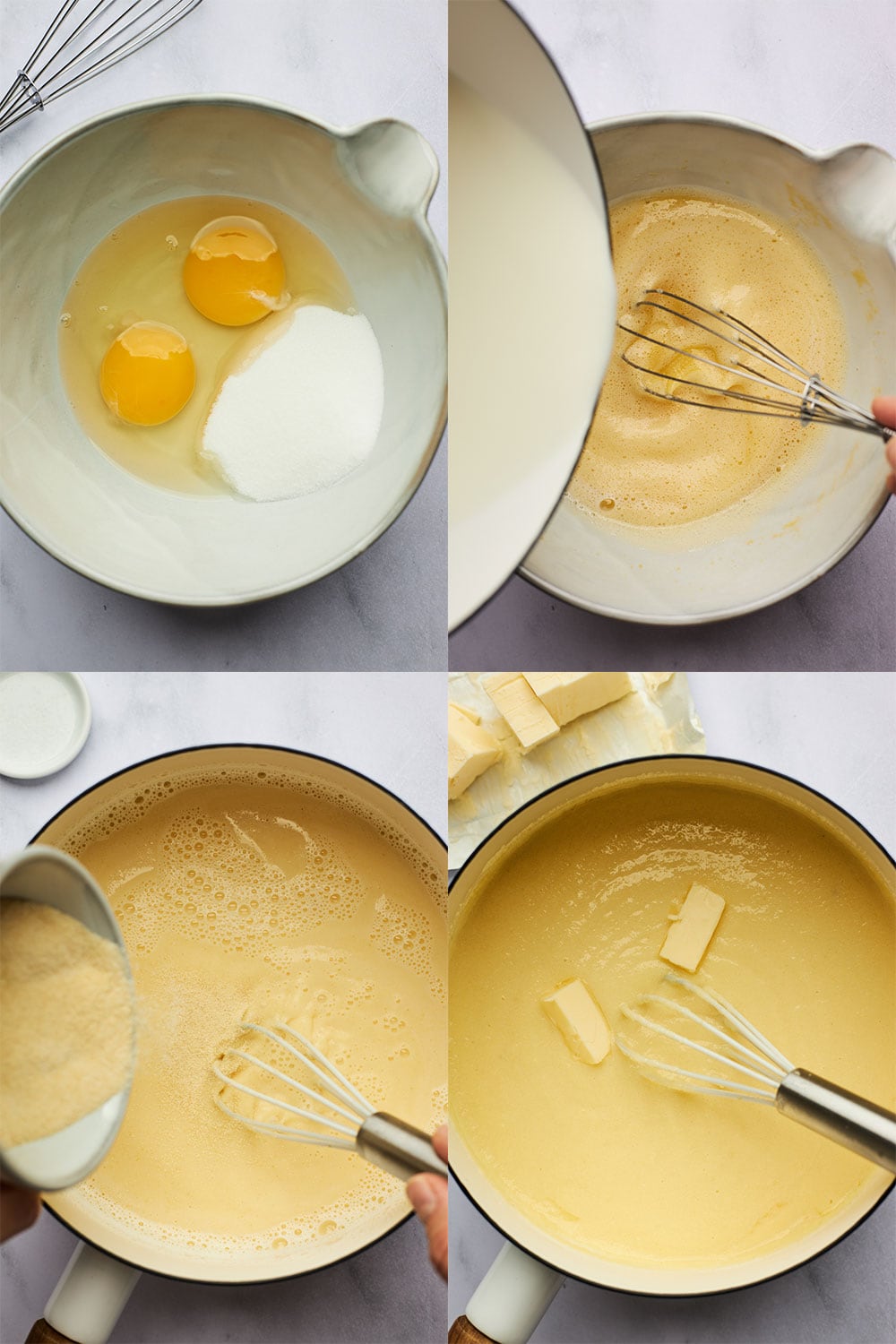
How To Make Bougatsa
- Prepare the Custard: Star by warming your milk over medium heat. While it is warming whisk your eggs until frothy then whisk in the sugar until smooth. Slowly drizzle in the hot milk while whisking tempering the eggs and once combined transfer the whole mixture back into the pot and whisk and cook until sugar is dissolved. Sprinkle in the semolina and pinch of salt while whisking and continue to whisk and cook over medium low heat until thickened. Whisk in the cubed butter then off the heat whisk in the vanilla and lemon zest - allow to cool to room temperature
- Preparing & Using Phyllo: Thaw phyllo overnight in the refrigerator. As a last resort only, thaw at room temperature for five hours and use immediately. Prepare all ingredients for your recipe before opening the thawed phyllo. Remove the thawed phyllo from the package and unroll the sheets. Cover the unrolled phyllo with a sheet of waxed paper or plastic wrap covered by a damp towel to keep it moist. It dries out very quickly. As you remove one sheet at a time, cover the remainder. If you tear a piece of phyllo by mistake, don’t worry. You can patch pieces together to use in a middle layer of the pastry, and this will rarely if ever, show in the final product. you will need approx 9 sheets of phyllo pastry for this recipe.
- Assemble Bougatsa: Lightly butter prepared pan then layer 5 sheets of phyllo lightly brushing or sprinkling with butter between layers and letting layers hang over the edges of pan. Spoon custard over the phyllo. Fold in the edges of phyllo over the custard then crinkle and butter 3-4 more phyllo sheets over the custard. Transfer to preheated oven and bake until golden
- Serve: Allow to cool in the pan 10 minutes then transfer to cutting board and slice warm and enjoy dusted with powdered sugar and or cinnamon (I always recommend serving bougatsa warm)
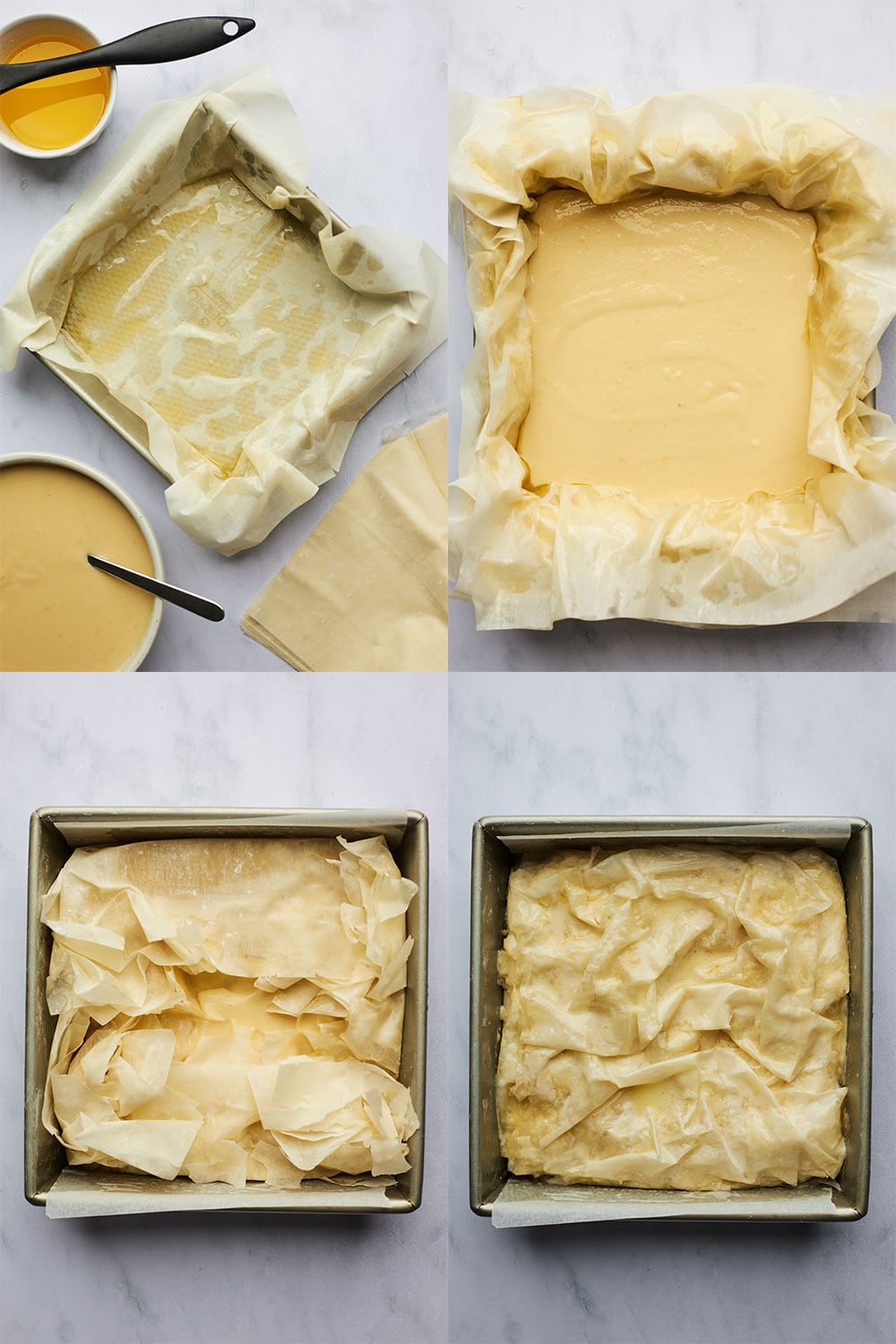
Homemade Bougatsa Tips
- Allow creamy custard filling to cool to room temperature before spooning onto the phyllo layers to ensure a crispy bottom layer - you don’t want a soggy bottom
- Drizzle or brush phyllo very lightly with butter - don’t over do it with the butter just enough to moisten the phyllo a bit otherwise you will end up with a very greasy bougatsa
- Crinkling the top layers instead of laying them flat is optional but makes the top layers even crispier
- Sprinkle icing sugar and or cinnamon right before serving as opposed to right out the oven as the heat coming off the bougatsa will absorb it
- Bougatsa can be served cold but I recommend serving it warm right out the oven - allow it to cool in the pan 10 minutes then use the parchment paper to slide it onto a cutting board and slice and enjoy warm
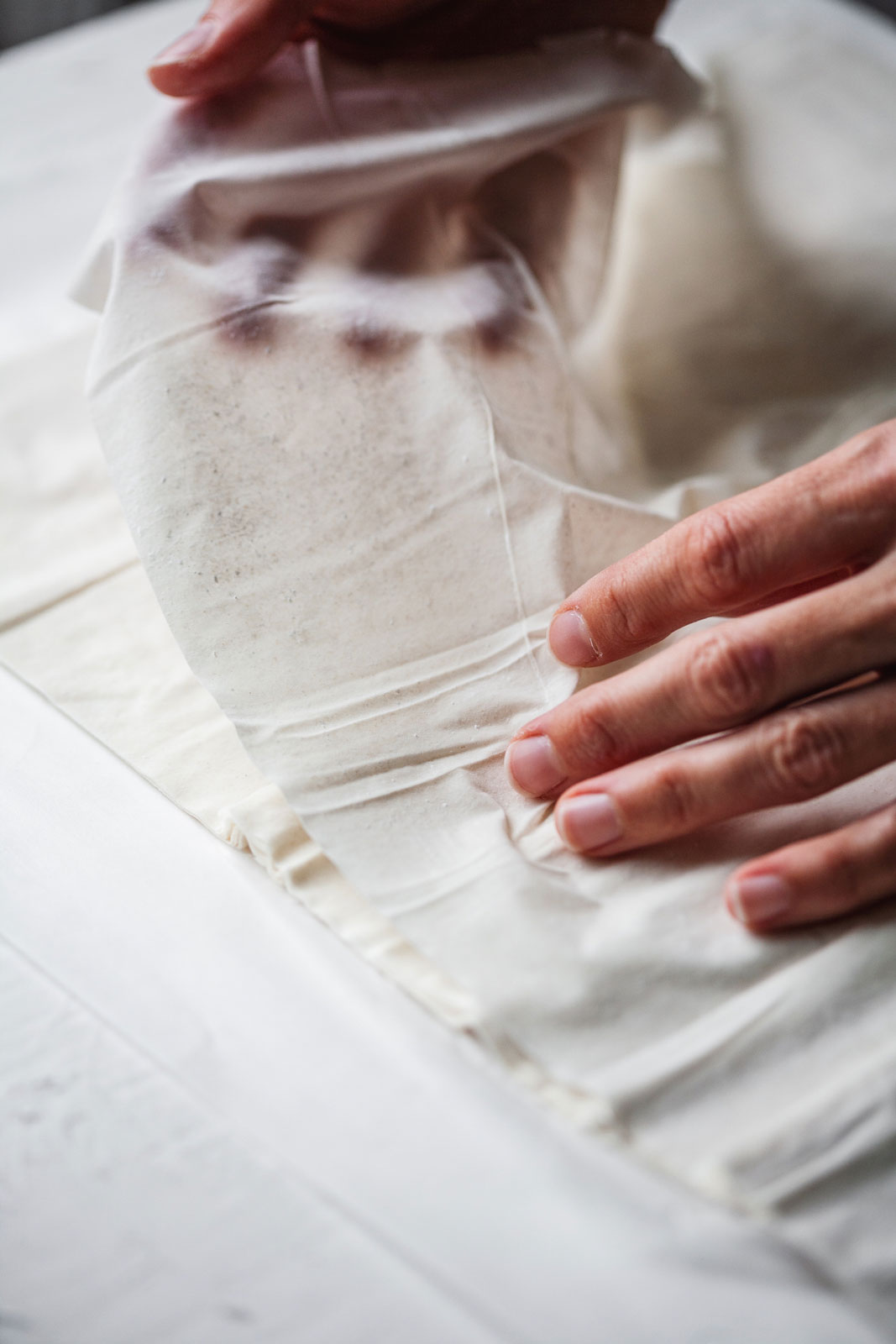
I on the other hand generally stay away from dairy unless it’s goat feta and cheese in my sandwich and the odd gorging on a charcuterie platter so custards and creamy things are usually a little too heavy for me. Not that I don’t like them but 1-2 bites is all that I need and then I’m done. That being said this one was not overly sweet and it beckoned me to have more than one piece.
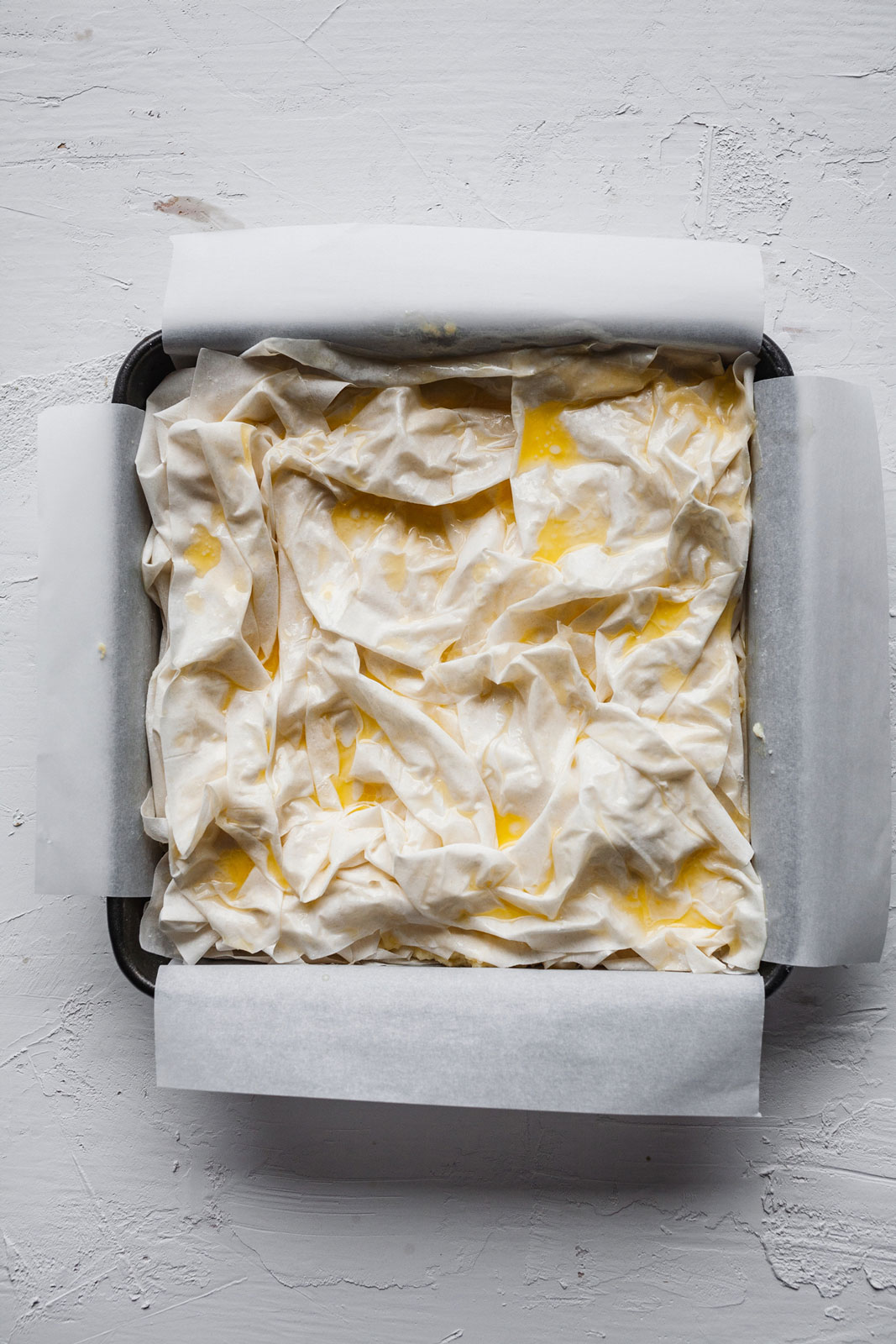
Tried & Tested Bougatsa Variations:
- 2 Whole Eggs: Can I use two whole eggs instead of the egg and one yolk? I have tried this recipe with 2 whole eggs and with just one egg and then with one whole egg and a yolk and the latter as stated in the recipe yields the best texture. I found the 2 whole eggs really made the custard a bit too tight or firm (especially for the ratio of milk to eggs for this amount of custard) - the 1 egg plus yolk added just enough richness to the custard but it allowed for a much lighter filling not as thick or dense - that being said using 2 whole eggs saves you wasting the white so if it doesn’t bother you to have a denser thicker custard filling then by all means use 2 eggs vs 1 whole egg + 1 yolk
- Lemon zest & Juice: I have made bougatsa with and without the lemon zest and I prefer it with the lemon zest for the best flavour always - it’s not overpowering at all but the perfect flavour with the vanilla - the vanilla is a must! The lemon juice is totally optional but I left it out of the updated recipe because I found it didn’t do much for the flavour of the custard really and it thickened the mixture more than I wanted it so I left it out of the recipe - it won’t hurt if you add a splash of it so its up to you
- Phyllo layers: I played around a lot with the phyllo layers and I consistently found that the bottom layers had to be at least 4 sheets preferably 5 sheets in thickness to hold up to the custard. Once the excess edges were folded over the custard you could easily get away with 3-4 crinkled half sheets of phyllo brushed with butter in-between and on top - that was enough coverage. Clearly if you are doubling the recipe and using a 9x13 pan you would have to use more sheets on top as more of the custard will be exposed in a larger pan
- Flour VS Semolina: Can I use Flour instead of Selina? I say semolina all the way only because that is what I’m use to making my bougatsa with and I love the texture of the custard with it but using flour works too. The only thing I would change if you are using all purpose flour instead of semolina in this recipe is whisking the flour in with the sugar and the egg and yolk for a smoother custard. It will work if you add it to the milk mixture after but you may get some clumps in the custard - so for a smoother custard I recommend whisking the flour into the eggs and sugar before the hot milk gets added to the mixture - other than that its 1-1 swap if you prefer flour over semolina.
- Vegan Bougatsa: Can I make vegan bougatsa? I tried making this recipe 2 ways to make it vegan. So as you probably already know most storebought phyllo pastry is already vegan so that wasn’t really an issue. The issue was the custard and the eggs. TEST 1: using egg replacer I used Bob’s red Mill egg replacer and almond milk and made this recipe completely as written heating the milk up, whisking the egg replacer with sugar then the hot milk then heating it back up with the semolina. The outcome - Ok so this particular egg replacer has baking soda in it so the custard REALLY puffed up when baking (I almost feel like I would cut a vent into the middle of pastry next time) ofcouse it settled down after it came out of the oven but just an FYI when making it this way. The almond milk was a great choice because it had a much more neutral flavour then when I used coconut milk although coconut milk added a wonderful flavour and texture it didn’t taste like traditional bougatsa - so I would stick with almond milk or cashew milk for a more traditional flavour. One more thing about the egg replacer - while I was whisking it after the semolina was added it got really gummy likely due to potato starch and tapioca flour in the egg replacer mix but eventually it smoothed out and the texture was really nice - overall the flavour was good and so was the texture - possibly a little thicker than I wanted but I think next time I would reduce the egg replacer to one egg and not 1 and a half eggs (to account for that yolk I thought). I used vegan butter but I would recommend even a good quality margarine that you enjoy the taste of as the vegan butter didn’t quite give the Bougatsa its buttery phyllo flavour. TEST 2: Test two was the easiest way to make bougatsa vegan and that was to use the vegan butter or margarine, use almond milk or cashew milk and omit the eggs all together in the recipe. I cooked the custard a little longer until it was really nice and thick and it baked up just fine without the egg replacer. So there you have it - two methods and both quite good - it’s a matter of if you have egg replacer and if you want to use it.
- Tempering Eggs: A lot of recipes call for whisking the eggs right into the hot milk sugar semolina mixture and that is also quite fine - the only thing with that is that if the liquids are even just a little warmer than you would like it could cook the eggs too much. This is why I prefer to whisk the eggs and sugar seperately and gradually stream in the hot milk while whisking them which introduces the hot milk very slowly and gradually into the egg mixture with less possibility of scorching or cooking the eggs. The eggs will thoroughly combine with the hot liquid without scrambling. If you feel comfortable doing it all in one pot though go for it just ensure that you have the heat on very low.
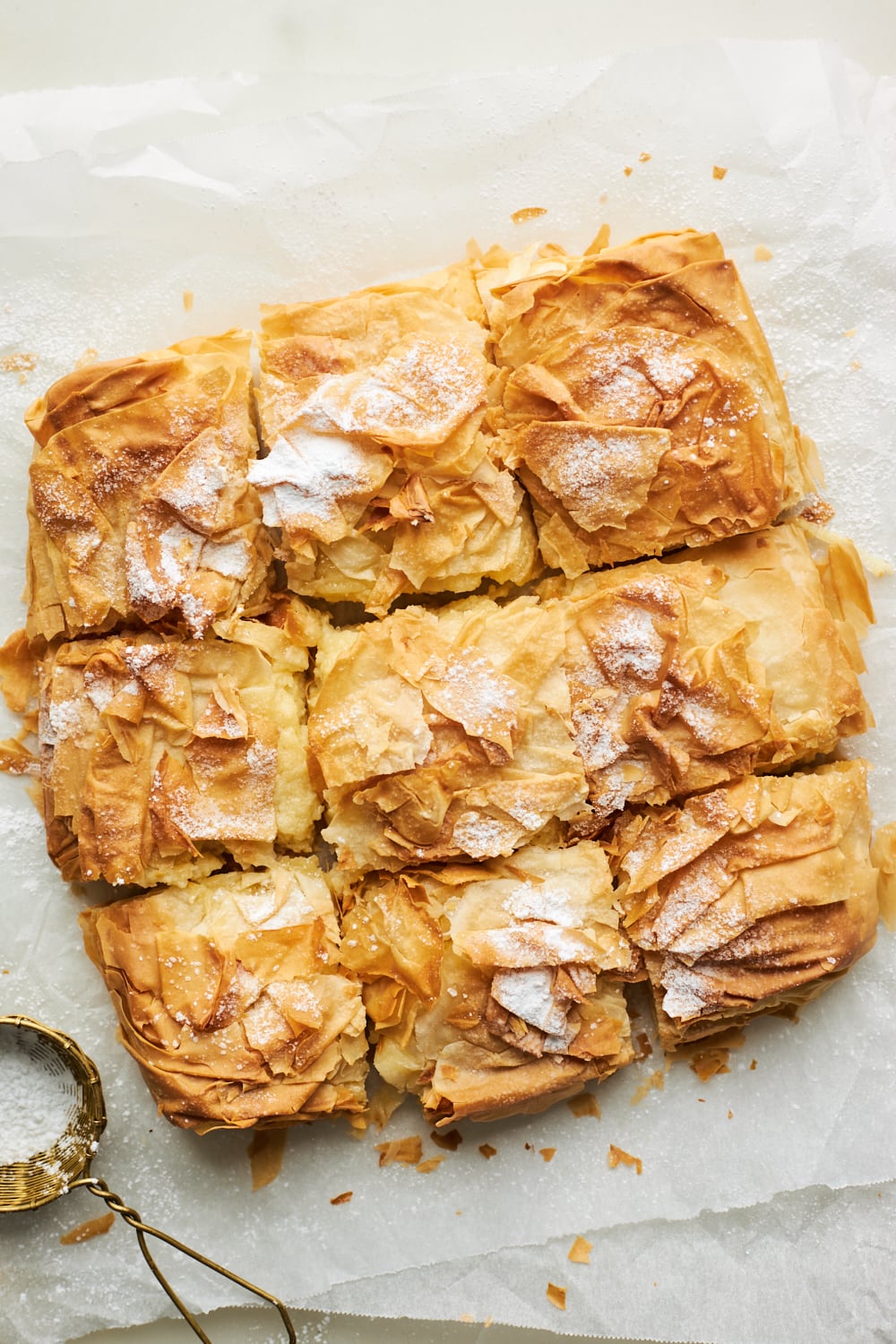
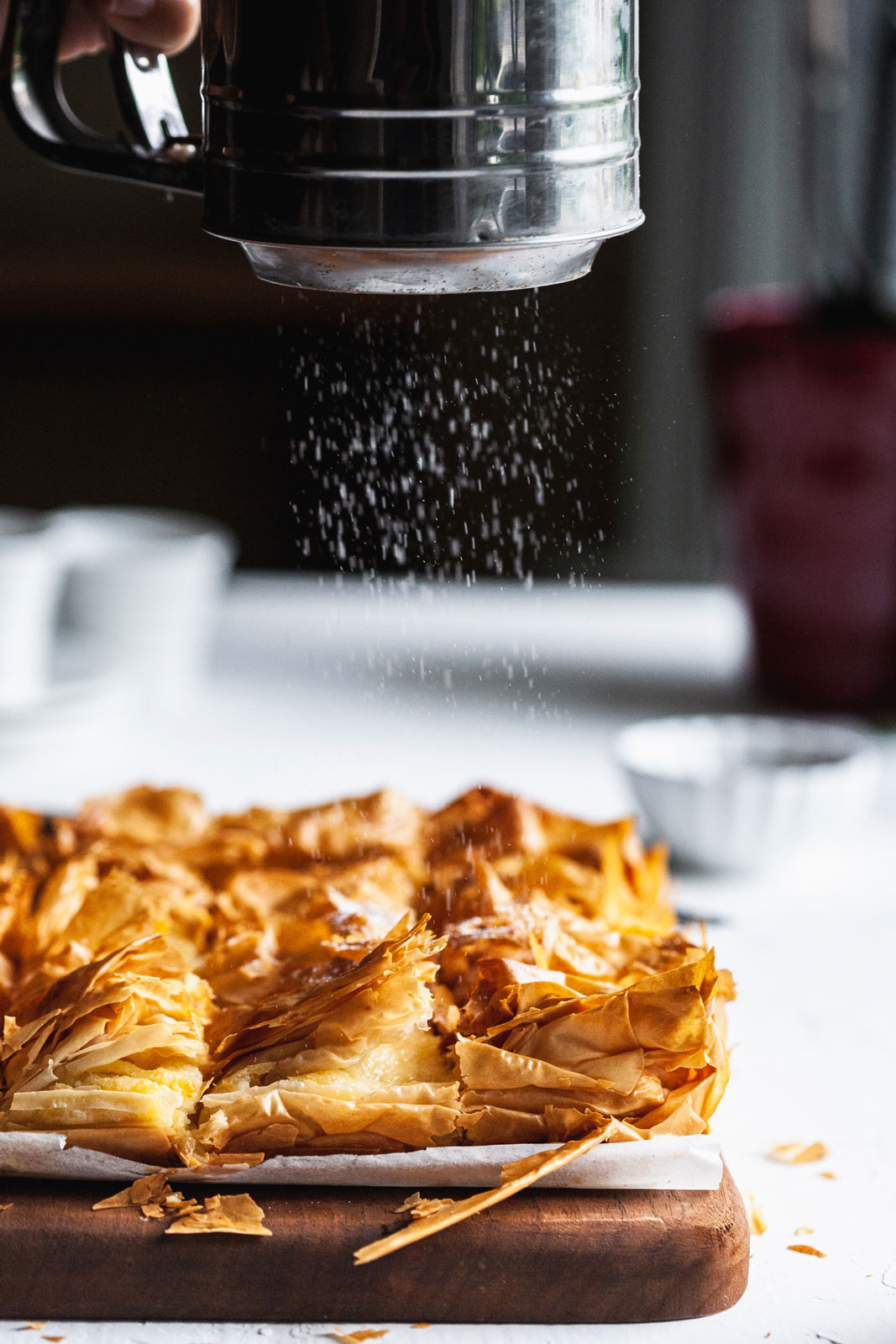
There are quite a few versions of this recipe and to tell you the truth I’m sure they are all delicious. Why I make mine this way is because it’s a very simple recipe. It doesn’t taste eggy at all. The custard is super easy to make and the whole thing is also easy to put together. It also doesn’t have a ton of sugar in it which I love. I also love the size of this one too. It makes just enough for a small brownie tin. Some recipes call for a huge amount which could feed an army. You most definitely can double and triple the amounts if you are feeding an army but if not than this recipe is perfect for you as it is for me.
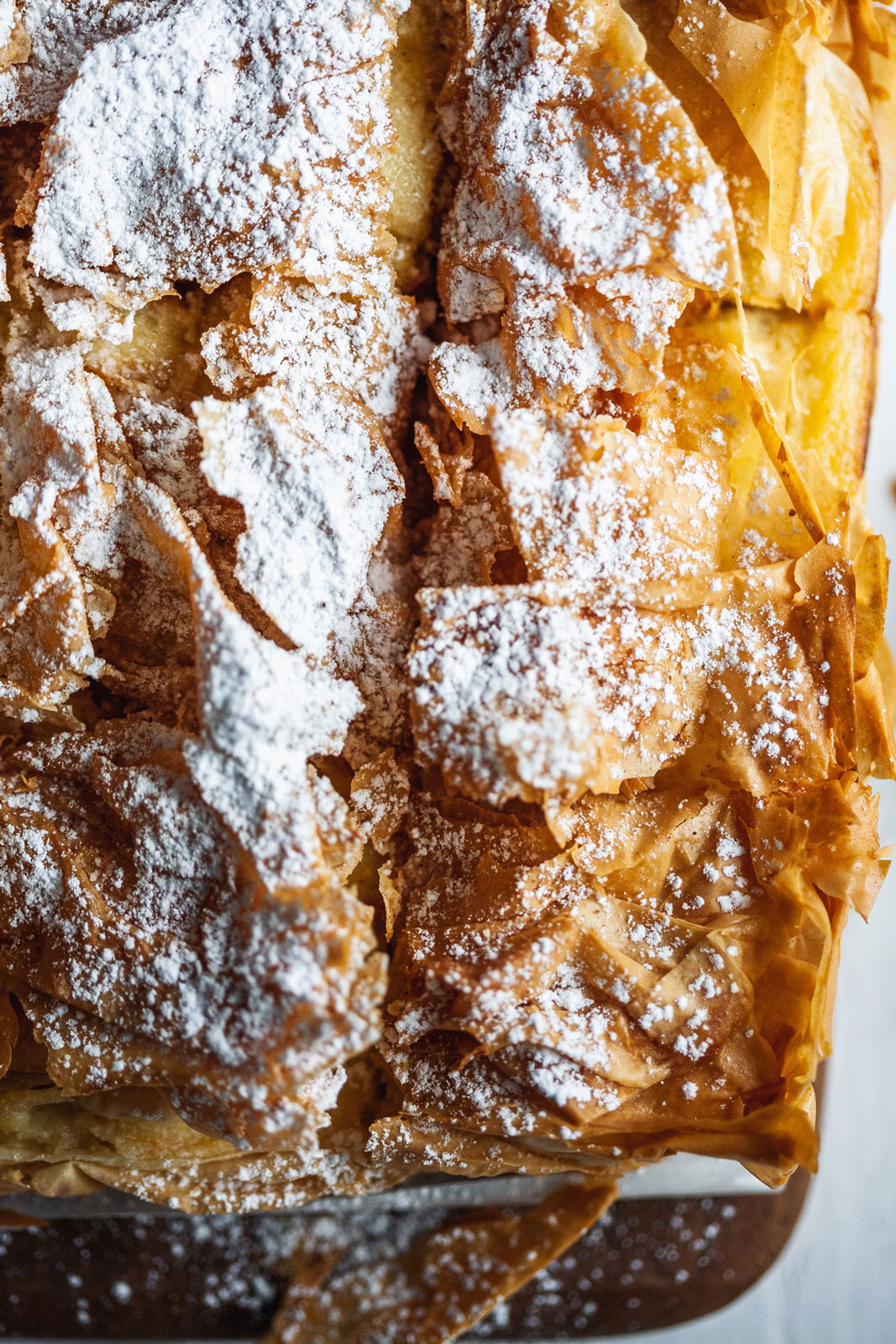
Storage & Make Ahead
- STORAGE: Bougatsa is best eaten the day it is baked. Leftover bougatsa can be stored in the fridge in an airtight container for 2-3 days. To reheat I recommend doing so in a toaster oven or oven on sheet pan at 350 degrees F until warmed through to maintain some crispiness to the phyllo
- Make Ahead: The custard can me made a day ahead. Once off the heat place a piece of plastic wrap right over the custard touching it to prevent a skin from forming on top, allow to cool to room temperature them store in the fridge over night. Remove from fridge ½ hour before you plan on making your bougatsa to allow custard to come to room temperature then whisk and spread into pan when ready to use as directed in recipe.
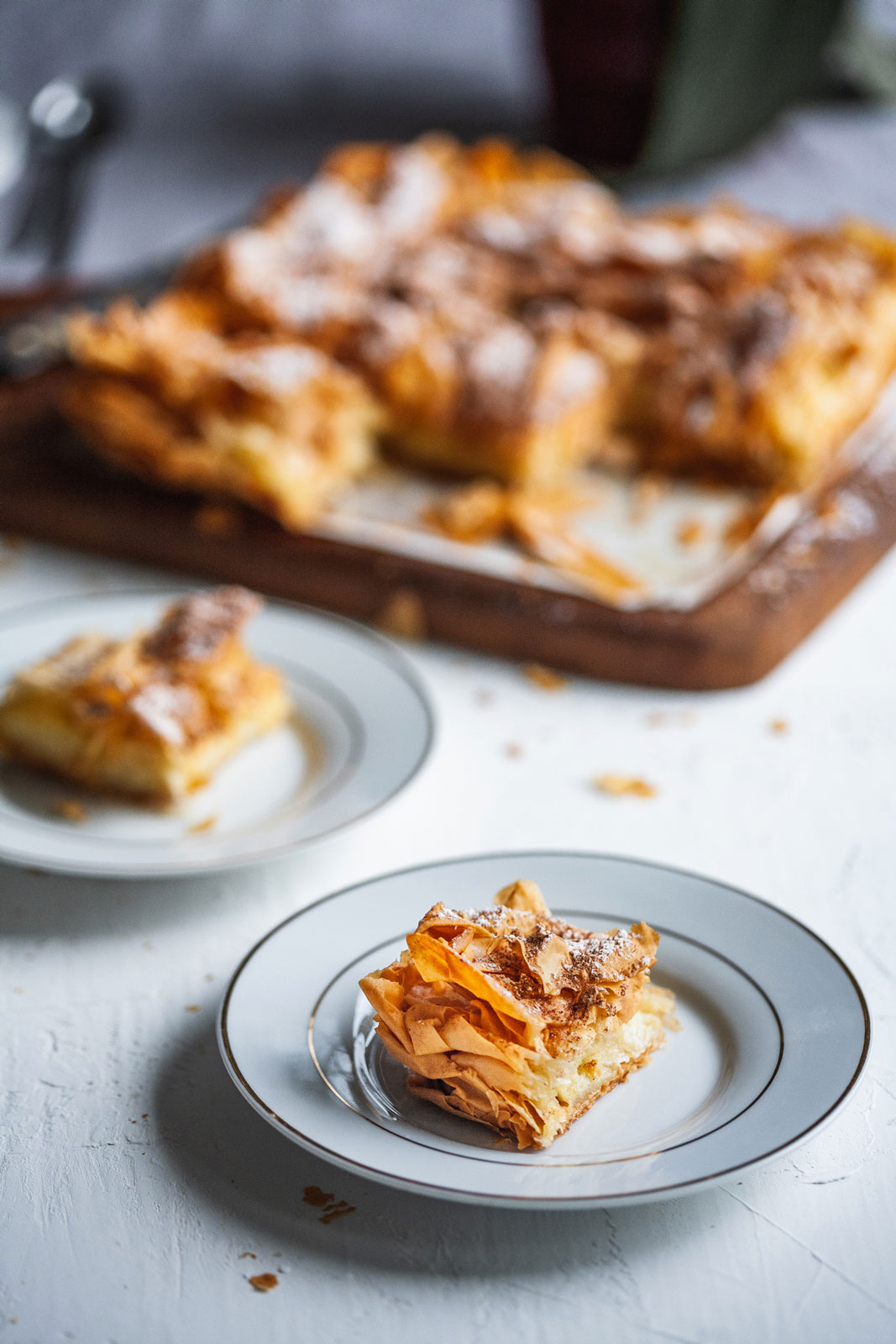
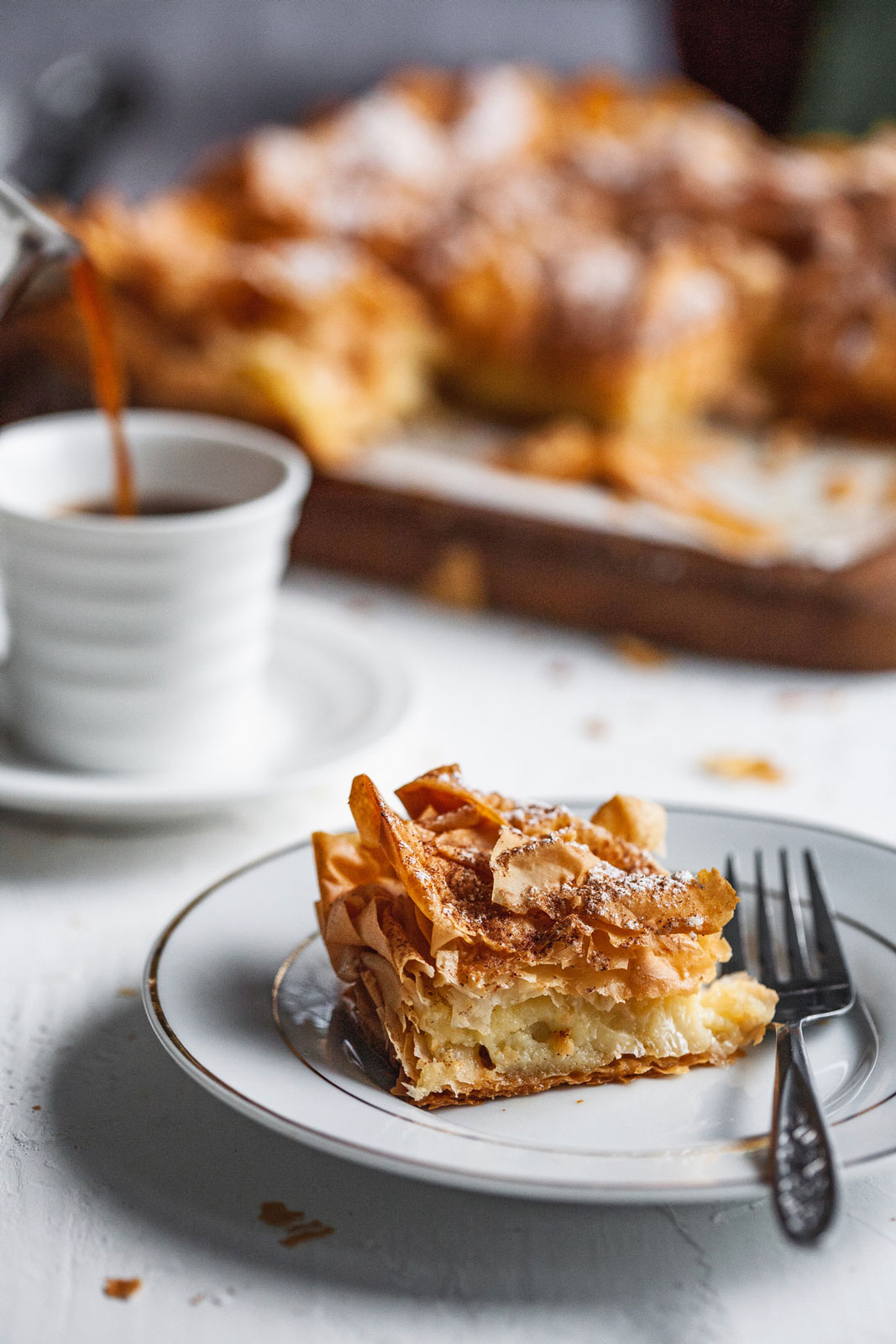
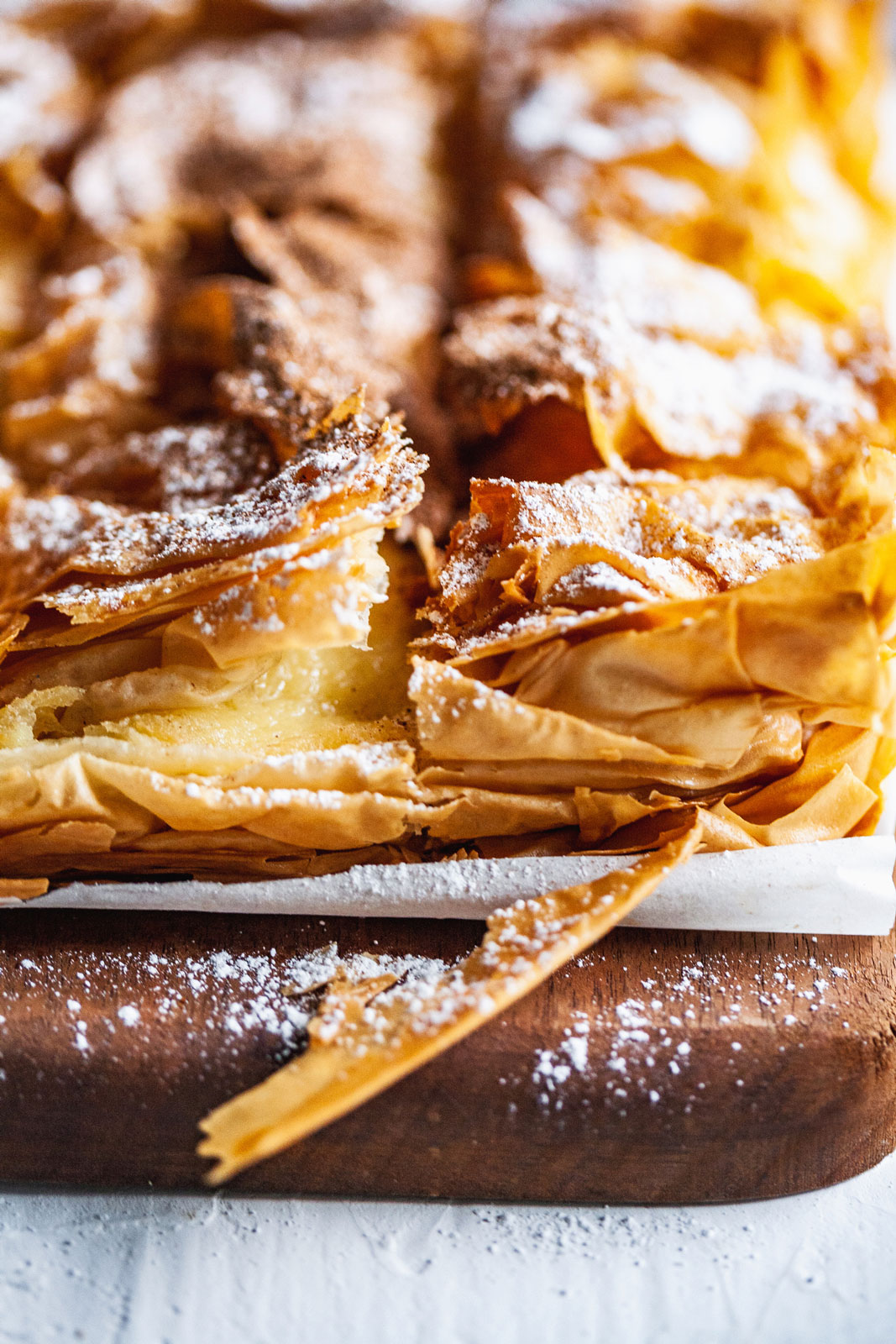
If You Liked This Recipe You Will Love These:
Recipe
Ingredients
- 1 large whole egg, room temperature
- 1 egg yolk
- ¼ cup sugar
- 1½ cups whole milk
- ¼ cup semolina (farina)
- Pinch of Salt
- ½ cup butter, cut into cubes
- Zest of one lemon, (optional)
- 1 teaspoon vanilla extract
- 9 phyllo pastry sheets, thawed, covered with damp towel
- ¼-½ cup butter, melted for brushing phyllo with
- Icing sugar (for dusting)
- Cinnamon (for dusting)
Directions
- In a medium bowl whisk egg and yolk until frothy; beat/whisk in sugar until thick and foamy, about 3-4 minutes and then set aside.
- Heat milk in medium pot or saucepan over medium heat until milk is hot but not boiling, you can also heat in the microwave.
- Remove milk from heat and slowly drizzle into the egg mixture in a thin steady stream while whisking the entire time. (This will temper the eggs/egg mixture so that eggs don’t cook/scramble if added right into hot milk.)
- Pour custard milk mixture back into the pot and set on medium to medium-low heat; cook, stirring constantly, about 2-4 minutes or until sugar has completely dissolved while stirring.
- Gradually sprinkle in semolina while whisking and then add a pinch of salt. Reduce heat to medium-low heat and, cook, stirring constantly, until thickened and can easily coat the back of a spoon, when the whisk passes through it it leaves streaks and is nice and smooth, about 5-7 minutes.
- Whisk in pieces of cubed butter, incorporating completely into the semolina custard. Then whisk in the vanilla and the lemon zest. Remove from heat and allow to cool to room temperature while preparing your phyllo. (If making ahead of time cover with a piece of plastic wrap directly onto the surface of the custard and cool completely to avoid skin from developing. Refrigerate once cool and chill overnight. Allow to come to room temperature before making and baking bougatsa. )
- Preheat oven to 350°F and line a 8x8 square brownie tin or baking dish with overhanging strips of parchment paper (for easy removal) then brush lightly with butter to grease and set aside.
- Unroll one sheet of phyllo, keeping remainder covered with plastic wrap and dampened kitchen towel. Place your melted butter close to your prepared pan along with a pastry brush or spoon for sprinkling or brushing butter on phyllo.
- Take one sheet of phyllo and very gently and gingerly place it into the pan allowing the ends to fall over the side of pan. Then sprinkle butter generously over the whole layer. Repeat phyllo and butter sprinkling with 4 more layers (5 in total). (Do not brush on the butter but instead sprinkle it on between layers to keep the phyllo pastry light and crisp).
- Spoon in the custard filling and smooth evenly over the phyllo layers. No butter needed over the custard. Fold the excess phyllo that overlap the pan in over all the edges onto the custard and lighlty brush/sprinkle them with a little butter - there will still be some custard showing.
- To cover the top place 3-4 more layers of crinkled phyllo - I usually use half sheets beacause they are just going over the custard sprinkling butter in between layers and then lightly brush on the remaining butter over the top layer tucking in any phyllo edges with your buttered brush along the edges of the pan
- Transfer pan to oven and bake for approx 30-40 minutes or until golden brown and crispy and fragrant.
- Remove from oven and allow to cool 10 minutes in pan then use the parchment paper to remove from pan and slide bougatsa onto a wire rack to cool completely or I recommend eating it warm so I transfer it to cutting board and slice.
- Serve with a dusting of powdered sugar or cinnamon or both and enjoy
